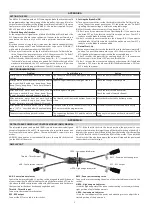
______________________________________________________________________________
27
Steep Spiral Dive
A maximum sink rate of over 15 meters
per second can be achieved in a steep
spiral dive, but it is advisable to build up
gradually to these sink rates when you first
practise spiralling.
Getting the UP Makalu Light into a spiral
dive is very simple and has already been
described in the chapter regarding turning.
When entering the spiral it is essential to
induce the turn gradually; if you apply the
brake too quickly you may enter a spin. If
this
happens,
release
the
brake
immediately and let the glider recover
before trying again. Keep a steady tension
on the inside brake and observe the
increased angle of bank and sink rate. A
little brake on the outer wing will help
stabilize the glider at a high sink rate.
To recover from a spiral, simply release
the inside brake. Do this gradually to
prevent an uncontrolled steep climb
caused by the excess energy built up
during the dive. Be prepared for the glider
to climb a little and to damp out the
subsequent dive. Be warned that steep
spiral dives are equal to high G loading on
both you and your glider!
WARNING!
Spiral dives
with high sink rates expose
the pilot and material to
very high centrifugal forces
– incidents caused by pilots
falling unconscious during
spiral
dives
have
been
recorded.
Approach this manoeuvre with caution.
NEVER fly a spiral dive with Big Ears
engaged
– this could lead to a
catastrophic material failure!
B-Line Stalls
To induce a B-line stall, start from normal,
un-accelerated flight. Reach up and take
hold of both B risers, still with your
hands in the brake loops, and pull
down simultaneously by approximately
15 cm. The first few centimetres of
travel will be quite hard, but as the
glider settles into the stall so the effort
becomes less.
The glider will drop back a little as it
stalls, and then centralize over your
head. With 15 cm or so of pull a sink
rate of up to 9 meters per second can
be achieved. With less pull you will get
a decrease in sink rate. The B-risers
should not be pulled beyond this point,
as it may result in the canopy entering
an unstable phase or going into a
frontal
rosette.
Should
you
inadvertently have pulled too far down
on the B-risers, simply release them a
little again until the wing is again stable
above you, showing the characteristic
deep crease along the B-level and
being fully stretched out spanwise.
To recover from a B-line stall, the
risers should be released abruptly and
simultaneously. Doing so will allow the
wing to re-inflate completely and
resume normal flight. It is not unusual
for the canopy to dive in front of the
pilot as the wing regains speed, angles
of up to 30-45° are perfectly normal. In
this phase the pilot should NOT
engage the brakes!
WARNING!
Releasing the B-stall too
slowly, or asymmetrically, can lead to
dangerous situations. Always practise
manoeuvres
under
professional
guidance and over water!
Big Ears
To pull the ears in, reach up and get
hold of the outermost A-line on both
front risers and pull them down,
simultaneously, by about 20 to 30 cm
until the tips collapse. Keep these two
Summary of Contents for Makalu Light
Page 6: ...______________________________________________________________________________ 6...
Page 43: ...43 Attachments Line plan...
Page 44: ...44 Luftsportger te Kennblatt Makalu Light XS L...
Page 45: ...45...
Page 46: ...46...
Page 47: ...47...
Page 48: ...48...
Page 49: ...49...
Page 55: ...55 UP International GmbH Kreuzeckbahnstrasse 7 82467 Garmisch Partenkirchen GERMANY...
















































